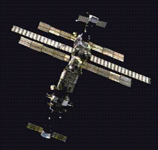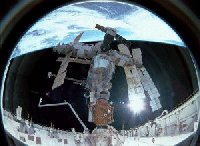
Space Station Mir as seen from a Soyuz space capsule on final docking approach
Image found on the internet

The Mir orbital space station was the most successful space project of the Russian nation during the late 20th century. Not until the Russian and American nations collaborated to build the Freedom space station was there a more successful or long lived space station in Terran orbit.
As with the Salyut space stations before it, Mir was built upon a modular approach. But, Mir took greater advantage of this and expanded upon its basic core station many times to add extra docking ports and experimental sections.

In Terran English, "Mir" is Russian for "Peace," and this space station lived up to its name. During the 1990's, a number of missions on board the station were composed of not only Russian cosmonauts but also American astronauts. Bitter enemies throughout the cold war, these two superpowers were able to put aside their differences in the interest of peace and scientific progress. In addition to having American astronauts, the space station itself was visited and resupplied frequently by the United States space shuttle Atlantis. This era of cooperation paved the way for the international space station Freedom, completed and manned in the early 21st century by both American and Russian scientists, in addition to astronauts from other countries.

Specifications:
Length: 13.1 meters
Diameter: 4.2 meters
Mass: 21 tonnes
Crew: 6
Docking Ports: 6
Propulsion: 32 chemical attitude control rockets rated at 1.4 newtons of thrust each